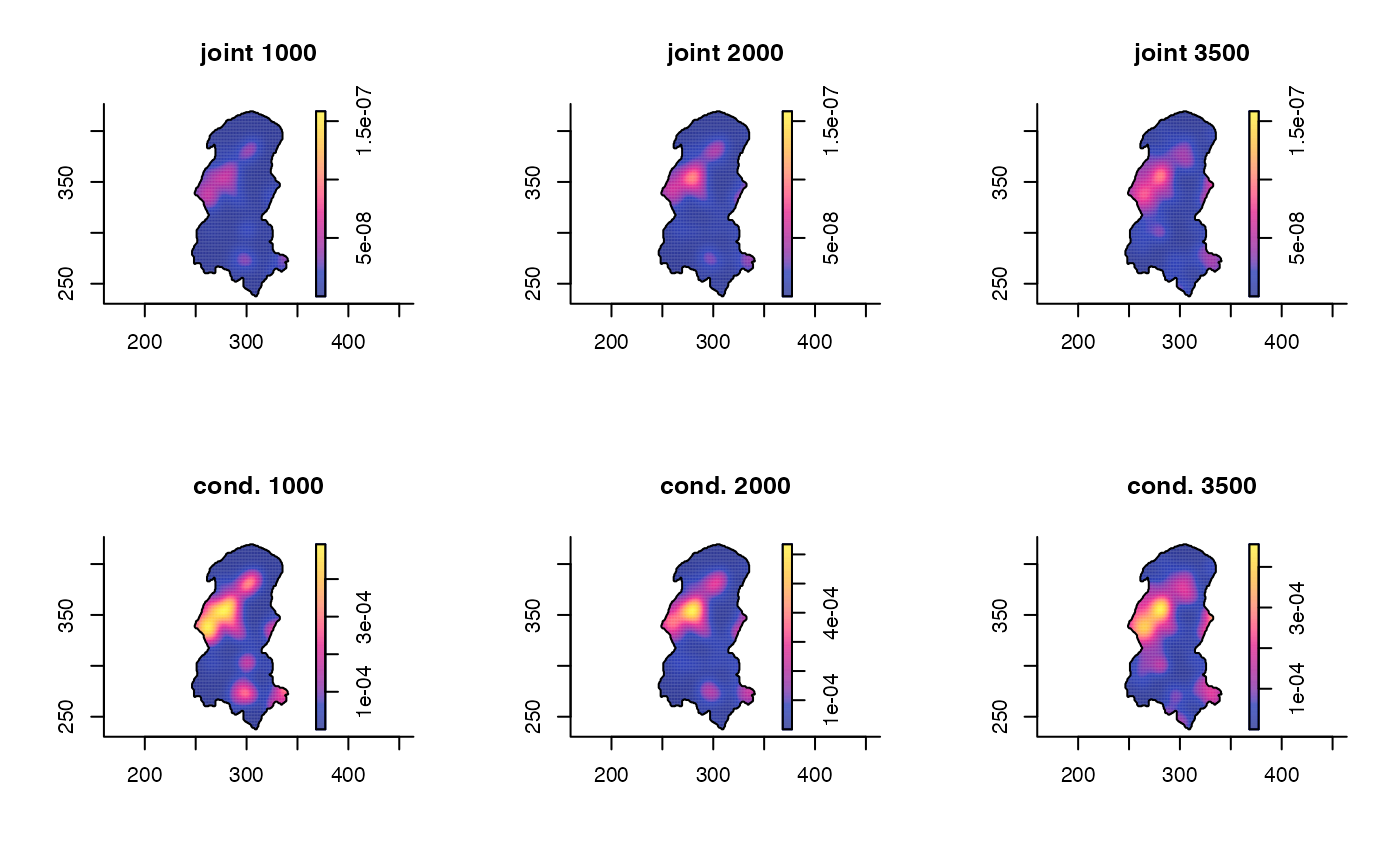Spatiotemporal kernel density estimation
spattemp.density.RdProvides a fixed-bandwidth kernel estimate of continuous spatiotemporal data.
spattemp.density(pp, h = NULL, tt = NULL, lambda = NULL,
tlim = NULL, sedge = c("uniform", "none"), tedge = sedge,
sres = 128, tres = NULL, verbose = TRUE)Arguments
- pp
An object of class
pppgiving the spatial coordinates of the observations to be smoothed. Possibly marked with the time of each event; see argumenttt.- h
Fixed bandwidth to smooth the spatial margin. A numeric value > 0. If unsupplied, the oversmoothing bandwidth is used as per
OS.- tt
A numeric vector of equal length to the number of points in
pp, giving the time corresponding to each spatial observation. If unsupplied, the function attempts to use the values in themarksattribute of theppp.objectinpp.- lambda
Fixed bandwidth to smooth the temporal margin; a numeric value > 0. If unsupplied, the function internally computes the Sheather-Jones bandwith using
bw.SJ(Sheather & Jones, 1991).- tlim
A numeric vector of length 2 giving the limits of the temporal domain over which to smooth. If supplied, all times in
ttmust fall within this interval (equality with limits allowed). If unsupplied, the function simply uses the range of the observed temporal values.- sedge
Character string dictating spatial edge correction.
"uniform"(default) corrects based on evaluation grid coordinate. Settingsedge="none"requests no edge correction.- tedge
As
sedge, for temporal edge correction.- sres
Numeric value > 0. Resolution of the [
sres\(\times\)sres] evaluation grid in the spatial margin.- tres
Numeric value > 0. Resolution of the evaluation points in the temporal margin as defined by the
tliminterval. If unsupplied, the density is evaluated at integer values betweentlim[1]andtlim[2].- verbose
Logical value indicating whether to print a function progress bar to the console during evaluation.
Details
This function produces a fixed-bandwidth kernel estimate of a single spatiotemporal density, with isotropic smoothing in the spatial margin, as per Fernando & Hazelton (2014). Estimates may be edge-corrected for an irregular spatial study window and for the bounds on the temporal margin as per tlim; this edge-correction is performed in precisely the same way as the "uniform" option in bivariate.density.
Specifically, for \(n\) trivariate points in space-time (pp, tt, tlim), we have
$$\hat{f}(x,t)=n^{-1}\sum_{i=1}^{n}h^{-2}\lambda^{-1}K((x-x_i)/h)L((t-t_i)/\lambda)/(q(x)q(t)),$$
where \(x\in W\subset R^2\) and \(t\in T\subset R\); \(K\) and \(L\) are the 2D and 1D Gaussian kernels controlled by fixed bandwidths \(h\) (h) and \(\lambda\) (lambda) respectively; and \(q(x)=\int_W h^{-2}K((u-x)/h)du\) and \(q(t)=\int_T \lambda^{-1}L((w-t)/\lambda)dw\) are optional edge-correction factors (sedge and tedge).
The above equation provides the joint or unconditional density at a given space-time location \((x,t)\). In addition to this, the function also yields the conditional density at each grid time, defined as $$\hat{f}(x|t)=\hat{f}(x,t)/\hat{f}(t),$$ where \(\hat{f}(t)=n^{-1}\sum_{i=1}^{n}\lambda^{-1}L((t-t_i)/\lambda)/q(t)\) is the univariate kernel estimate of the temporal margin. Normalisation of the two versions \(\hat{f}(x,t)\) and \(\hat{f}(x|t)\) is the only way they differ. Where in the unconditional setting we have \(\int_W\int_T\hat{f}(x,t)dt dx=1\), in the conditional setting we have \(\int_W\hat{f}(x|t) dx=1\) for all \(t\). See Fernando & Hazelton (2014) for further details and practical reasons as to why we might prefer one over the other in certain situations.
The objects returned by this function (see `Value' below) are necessary for kernel estimation of spatiotemporal relative risk surfaces, which is performed by spattemp.risk.
Value
An object of class "stden". This is effectively a list with the following components:
- z
A named (by time-point) list of pixel
images corresponding to the joint spatiotemporal density over space at each discretised time.- z.cond
A named (by time-point) list of pixel
images corresponding to the conditional spatial density given each discretised time.- h
The scalar bandwidth used for spatial smoothing.
- lambda
The scalar bandwidth used for temporal smoothing.
- tlim
A numeric vector of length two giving the temporal bound of the density estimate.
- spatial.z
A pixel
image giving the overall spatial margin as a single 2D density estimate (i.e. ignoring time).- temporal.z
An object of class
densitygiving the overall temporal margin as a single 1D density estimate (i.e. ignoring space).- qs
A pixel
image giving the edge-correction surface for the spatial margin.NULLifsedge = "none".- qt
A numeric vector giving the edge-correction weights for the temporal margin.
NULLiftedge = "none".- pp
A
ppp.objectof the spatial data passed to the argument of the same name in the initial function call, withmarksof the observation times.- tgrid
A numeric vector giving the discretised time grid at which the spatiotemporal density was evaluated (matches the names of
zandz.cond).
References
Duong, T. (2007), ks: Kernel Density Estimation and Kernel Discriminant Analysis for Multivariate Data in R, Journal of Statistical Software, 21(7), 1-16.
Fernando, W.T.P.S. and Hazelton, M.L. (2014), Generalizing the spatial relative risk function, Spatial and Spatio-temporal Epidemiology, 8, 1-10.
Kelsall, J.E. and Diggle, P.J. (1995), Kernel estimation of relative risk, Bernoulli, 1, 3-16.
Sheather, S. J. and Jones, M. C. (1991), A reliable data-based bandwidth selection method for kernel density estimation. Journal of the Royal Statistical Society Series B, 53, 683-690.
Silverman, B.W. (1986), Density Estimation for Statistics and Data Analysis, Chapman & Hall, New York.
See also
Examples
data(burk)
burkcas <- burk$cases
burkden1 <- spattemp.density(burkcas,tres=128)
#> Calculating trivariate smooth...
#> Done.
#> Edge-correcting...
#> Done.
#> Conditioning on time...
#> Done.
summary(burkden1)
#> Spatiotemporal Kernel Density Estimate
#>
#> Bandwidths
#> h = 11.2439 (spatial)
#> lambda = 459.5736 (temporal)
#>
#> No. of observations
#> 188
#>
#> Spatial bound
#> Type: polygonal
#> 2D enclosure: [246.4, 341] x [237.6, 419.4]
#>
#> Temporal bound
#> [413, 5775]
#>
#> Evaluation
#> 128 x 128 x 128 trivariate lattice
#> Density range: [6.845224e-12, 1.188266e-07]
# \donttest{
hlam <- LIK.spattemp(burkcas,tlim=c(400,5900),verbose=FALSE)
burkden2 <- spattemp.density(burkcas,h=hlam[1],lambda=hlam[2],tlim=c(400,5900),tres=256)
#> Calculating trivariate smooth...
#> Done.
#> Edge-correcting...
#> Done.
#> Conditioning on time...
#> Done.
tims <- c(1000,2000,3500)
par(mfcol=c(2,3))
for(i in tims){
plot(burkden2,i,override.par=FALSE,fix.range=TRUE,main=paste("joint",i))
plot(burkden2,i,"conditional",override.par=FALSE,main=paste("cond.",i))
}
 # }
# }